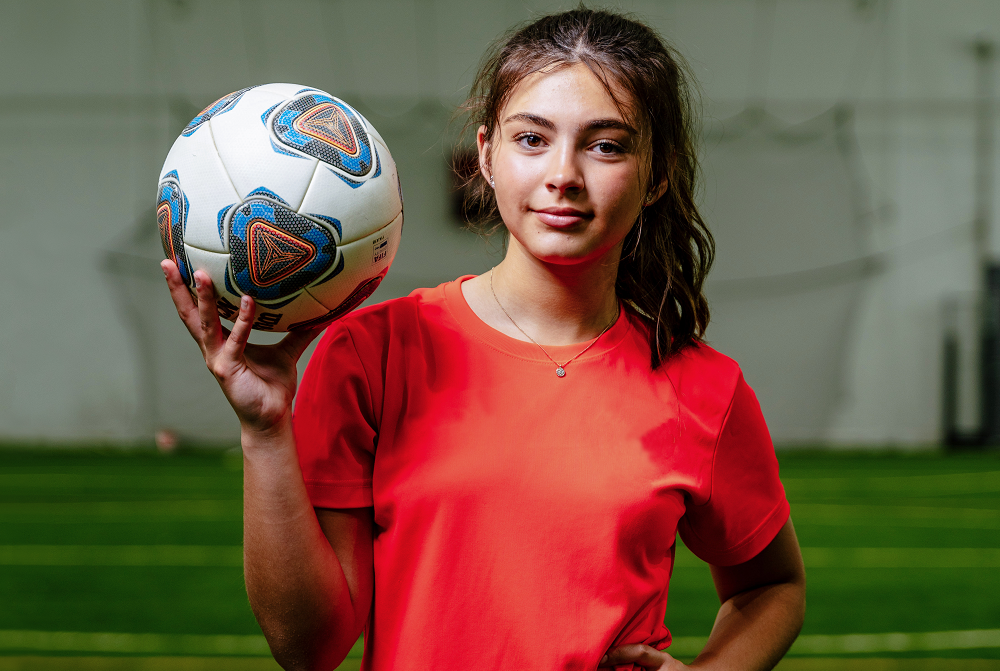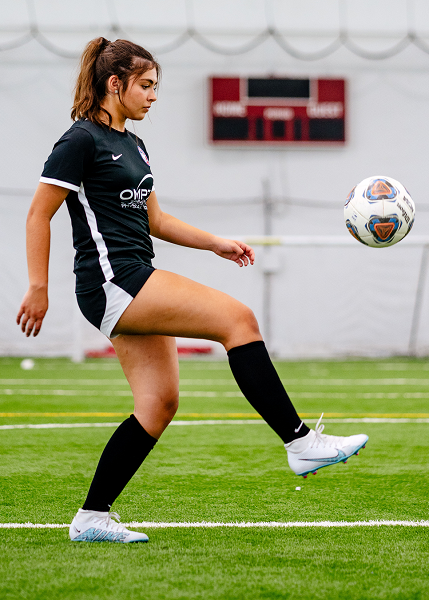
Macomb Lutheran North Standout on Mend After Knee Injury
October 3, 2023
Macomb Lutheran North freshman Emiliana Manzo has already achieved a long list of accomplishments, including a 3.8 grade-point average while juggling two sports she loves.
 As a point guard, she led her basketball team to an undefeated season in its division. She is also a center attacking midfielder, sometimes playing forward, on the 2009 Nationals Girls Academy Blue soccer team, ranked No. 1 in Michigan and 14th in the country.
As a point guard, she led her basketball team to an undefeated season in its division. She is also a center attacking midfielder, sometimes playing forward, on the 2009 Nationals Girls Academy Blue soccer team, ranked No. 1 in Michigan and 14th in the country.
In June of 2022, Emiliana hit a detour on her sports journey when she was participating in a club soccer national championship in Oceanside, Calif. With a few seconds left in the game and her team up 2-1, she ran 20 yards full speed to get to the ball. Hyperextending her left knee, she felt two pops. It was the first time she experienced an injury.
“I was screaming and crying and got taken off the field on a golf cart,” explains Emiliana. The trainer felt she was OK. Fortunately, she had the next day off and her knee was feeling better. The following day she played again, and 20 minutes into the game she knew there was an issue.
“Someone hit me from behind and I heard the pop again. I knew there was a problem.”
Emiliana’s father Vince Manzo said she experienced swelling, and the athletic trainer thought she may have a meniscus injury; however, she was able to continue to walk around during the championship in California before heading home.
Finding the Right Provider
Back in Michigan, Emiliana saw a few surgeons during her evaluation to seek treatment. When she met with Vasilios Bill Moutzouros, MD, chief of Sports Medicine at Henry Ford Health, she felt she met the right match.
“He treated me like an athlete and made me feel really comfortable,” she says.
 Vince adds that both he and Emiliana were also appreciative of something Dr. Moutzouros said during her evaluation: “He emphasized to Emiliana that she was an athlete before this injury, and she would be an athlete after the injury.”
Vince adds that both he and Emiliana were also appreciative of something Dr. Moutzouros said during her evaluation: “He emphasized to Emiliana that she was an athlete before this injury, and she would be an athlete after the injury.”
A detailed evaluation by Dr. Moutzouros revealed Emiliana had a complete anterior cruciate ligament (ACL) tear and medial and lateral meniscal tears. The meniscus, a C-shaped piece of tough, rubbery cartilage, acts as a shock absorber between the shinbone and the thighbone. It is one of the most common knee injuries. The ACL, one of the strong bands of tissue that help connect the thigh bone (femur) to the shinbone (tibia), is also prone to injury during sports when there are sudden stops or changes in direction.
Emiliana required physical therapy to get the swelling down and increase mobility before surgical repair.
Dr. Moutzouros reconstructed her ACL with her own patellar tendon graft and repaired her medial meniscus.
“She handled the surgery well and has been working very hard in her rehabilitation,” he says. “Her high-level soccer experience likely helped in her recovery as her range of motion and strengthening advanced so quickly.”
Understandably, Emiliana was nervous and scared when she went into surgery but expressed appreciation for the little things from Henry Ford like hearing “great music” as she was entering surgery, which gave her a sense of calm.
“That’s when I knew I picked the right doctor,” she said.
The Road to Recovery
As part of her recovery, after surgery which took place in July of 2022, Emiliana has undergone six months of physical therapy to increase mobility and strength training to get her leg strong again.
She also participated in the Return to Sport Program at the Henry Ford Center for Athletic Medicine to optimize recovery.
“We loved it,” says Vince. “It gave us peace of mind.”
Dr. Moutzouros explains that ACL prevention and rehabilitation programs are critical, especially for women because they have a four times greater risk of ACL tear than men. He says performance training post-surgery, along with an injury prevention program for those playing cutting sports, can markedly reduce the likelihood of future ACL injury.
“At Henry Ford, we work with physical therapists across the Midwest as well as our own. They do a great job in following our Henry Ford specific post-ACL reconstruction protocol,” he says. “After therapy runs its course, we strongly encourage our athletes to undergo performance training to allow a smooth transition back to sport.”
Nick Parkinson, supervisor of Athletic Training and Sports Performance at Henry Ford Health, emphasizes that the return to sport program is designed to bridge the gap between rehabilitation and returning to full activity in your chosen sport.
“Many times, insurance limits rehabilitation to regaining activities of daily living and not necessarily rebuilding the skills needed to play a sport or return to activity,” Nick says. “This program provides an affordable option to fill this need and return athletes to competition at the highest level.”
As for Emiliana, who hopes to play soccer in college and pursue a career in the medical field, she says this experience has taught her to not be afraid of injuries and treatment. She has also used the experience to volunteer for a program through the Girls Academy which serves as an advisory board to come up with ideas to help with mental and physical issues girls her age may be facing.
“For other kids who experience injuries, I’ve learned that this does not define you,” she said. “You can push through it, recover from it and be way better than you even were before.”
To find a sports medicine doctor or athletic trainer at Henry Ford, visit henryford.com/athletes.

MHSAA Survey Shows More Than 44 Percent of Athletes Play Multiple Sports
By
Geoff Kimmerly
MHSAA.com senior editor
August 17, 2022
More than 44 percent of athletes at Michigan High School Athletic Association member high schools participated in more than one sport during the 2021-22 school year, according to the Multi-Sport Participation Survey conducted this spring, the fourth such survey conducted by the MHSAA over the last five years to monitor the rate of specialization in school sports.
Early and intense sport specialization has become one of the most serious issues related to health and safety at all levels of youth sports, as overuse injuries and burnout among athletes have been tied to chronic injuries and health-related problems later in life. In early 2016, the MHSAA appointed a Task Force on Multi-Sport Participation as part of a continued effort to promote and protect participant health and address the issues leading to early sport specialization. The annual Multi-Sport Participation Survey, first conducted for the 2017-18 school year, was among results of the task force’s work. (No survey was conducted for 2019-20 as spring sports were canceled due to COVID-19.)
The MHSAA 2021-22 Multi-Sport Participation Survey received responses from 85 percent of member high schools, the highest response rate of the four years the survey has been conducted. Survey results showed a slightly lower percentage of member high school students participating in athletics compared to the inaugural survey in 2017-18 – but a higher percentage of multi-sport athletes among those playing at least one sport.
For 2021-22, schools responding to the survey showed 40.4 percent of their students participated in athletics during the last school year – 43.5 percent of boys and 37 percent of girls. Class D schools enjoyed the highest percentage of athletes among the entire student body, at 51.8 percent, followed by Class C (47.8), Class B (41.3) and Class A (37.7).
Those percentages – total and by Class – all were slightly lower than what was produced by the 2017-18 survey, which saw 42.5 percent of students total participating in athletics. However, the percentage of athletes competing in multiple sports in 2021-22 was higher than in 2017-18, 44.3 percent to 42.8 percent.
For 2021-22, 46.5 percent of male athletes and 41.4 percent of female athletes played multiple sports. Class D again enjoyed the highest percentage of multi-sport athletes among this group, at 60.8 percent, followed by Class C (58.5), Class B (49.5) and Class A (36.7).
Similar results for overall sport participation and multi-sport participation relative to enrollment size were seen by further breaking down Class A into schools of fewer than 1,000 students, 1,000-1,500 students, 1,501-2,000 students and more than 2,000 students. For both sport participation as a whole and multi-sport participation specifically, the smallest Class A schools enjoyed the highest percentages, while percentages then decreased for every larger size group of schools. This has remained consistent over the last five years.
“The multi-sport participation survey again shows that student-athletes across the state continue to focus on participation in several sports and the benefits that come with that participation for their school teams. What the numbers don’t show is the behind-the-scenes benefits of multi-sport participation,” said MHSAA assistant director Cody Inglis, who has served as coordinator of the multi-sport task force. “So many student-athletes see great success on and off the field with their teams, teammates, friends and peers while also developing the lifelong lessons that sports done right provide. We continue to believe and know that student-athletes who are involved in multiple sports are more successful, benefit from the variety of sports and see huge long-term benefits.”
The MHSAA Task Force on Multi-Sport Participation also recommended measuring multi-sport participation in MHSAA member schools to recognize “achievers” – that is, schools that surpass the norm given their enrollment and other factors that affect school sports participation.
In Class A, Bay City Central (78.7) and Livonia Franklin (77.7) posted the highest percentages of multi-sport athletes in 2021-22, with Clinton Township Chippewa Valley (75.6) and Parma Western (75.4) also reaching 75 percent. In Class B, four schools achieved at least 80 percent multi-sport participation – Brooklyn Columbia Central (85.8), Detroit Southeastern (84.6), Warren Michigan Collegiate (84) and Durand (82.6).
Class C saw five schools with more than 80 percent of its athletes taking part in more than one sport: Brown City (95.7), Decatur (87.4), Niles Brandywine (85.6), Ishpeming Westwood (83.2) and Flint Beecher (80.4). Five Class D schools responded at higher than 90 percent multi-sport participation, with Coldwater Pansophia Academy and Kinross Maplewood Baptist both reporting 100 percent of their athletes played multiple sports. McBain Northern Michigan Christian (98.6), Ewen-Trout Creek (94.3) and Detroit Douglass (91.7) were the next highest on the Class D list.
A total of 10 schools have appeared among the top 10 percent in their respective classes for multi-sport participation three of the four years of the survey: Battle Creek Harper Creek, Detroit Cody, Gibraltar Carlson, Grand Rapids Northview, Hamtramck, New Baltimore Anchor Bay, Ovid-Elise, Warren Lincoln, Athens and Maplewood Baptist.
The full summary report on the Multi-Sport Participation Survey is available on the Multi-Sports Benefits page of the MHSAA Website.

